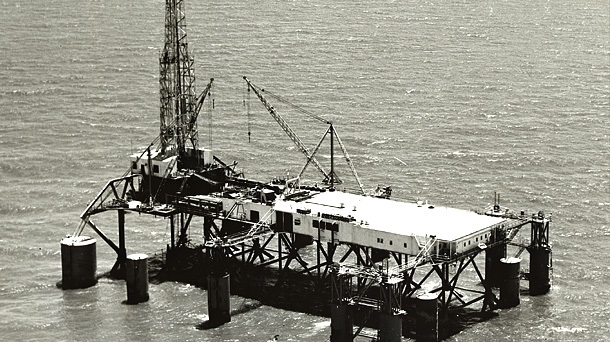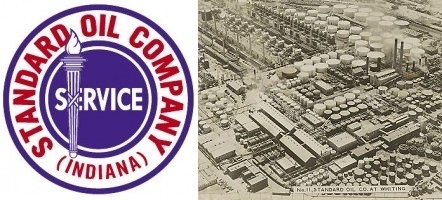June 12, 1879 – Allegheny Oilfield discovered by O.P. Taylor –
Orville “O.P.” Taylor completed the Triangle No. 1 well at a depth of 1,177 feet in Allegheny County, New York, revealing an oilfield that extended into Pennsylvania. His discovery came after two failed wells drilled near oil seeps first reported by a French missionary in in 1627. The Allegheny oilfield would launch a drilling boom and create the town of Petrolia.
Confederate Army veteran Taylor had worked in the cigar manufacturing business in Virginia before catching “oil fever” after reading about Pennsylvania oil discoveries along the Allegheny River (see Derricks of Triumph Hill). Taylor’s success led to his election as mayor of Wellsville, New York, and the title of “Father of the Allegheny Oilfield.” A Liberty Ship was named for him during World War II.
June 13, 1917 – Phillips Petroleum Company founded
During the early months of America’s entry into World War I, as oil prices rose above $1 per barrel, Phillips Petroleum Company was founded in Bartlesville, Oklahoma. Brothers Frank and Lee Eldas “L.E.” Phillips consolidated their oil companies and began operating throughout Oklahoma and Kansas. Assets rose from $3 million to $100 million within a few years.

Brothers L.E. Phillips (left) and Frank Phillips established Phillips Petroleum Company in Bartlesville in 1917. Photo courtesy ConocoPhillips.
In 1927, Phillips Petroleum began selling its gasoline in Wichita, Kansas, the first of more than 10,000 Phillips 66 service stations. The company’s high-octane aviation fuel played a key role in World War II (see Flight of the Woolaroc).
Phillips chemists received thousands of U.S. patents, including one in 1954 for Marlex, a high-density polyethylene. Wham-O toy company was the first to buy the new plastic (see Petroleum Product Hoopla).
Phillips Petroleum merged with Conoco in 2002 to become ConocoPhillips, which in 2007 established petroleum museums in Ponca City and Bartlesville.
June 13, 1928 – Hobbs Oilfield discovered in New Mexico
The New Mexico petroleum industry was launched with the discovery of the Hobbs oilfield near the southeastern corner of the state. After months of difficult cable-tool drilling, the Midwest State No. 1 well produced oil for the Midwest Refining Company, which had drilled the state’s first oil well in 1922.

A June 1928 oilfield discovery brought many decades of petroleum prosperity to downtown Hobbs, New Mexico.
The Hobbs well revealed a giant field, later cited by the New Mexico Bureau of Mines & Mineral Resources as “the most important single discovery of oil in New Mexico’s history.” But after months of drilling, the well had reached a depth of 1,500 feet when an engine house fire consumed the wooden derrick. “Men with less vision would have given up, but not the drillers of Midwest,” noted the state geologist.
As the Great Depression approached, oil production from the Hobbs field attracted investors and drilling companies, quickly transforming Hobbs from “sand, mesquite, bear grass and jack rabbits” to the fastest growing town in the nation.
Learn more in First New Mexico Oil Wells.
June 14, 1865 – First Daily Oil Region Newspaper
Pennsylvania’s oil region got its first daily newspaper when brothers William and Henry Bloss published a four-page broadsheet, the Titusville Morning Herald. Initial circulation was 300 for the community newspaper, which is still published – the Titusville Herald. The first edition’s articles included a reference to John Wilkes Booth’s visits to the region and his August 1864 oil interests.

The Pennsylvania newspaper’s first edition in 1865 noted John Wilkes Booth had oil interests.
The newspaper reported: “John Wilkes Booth purchased one-thirteenth interest in the territory in August 1864. We are credibly informed that this Homestead well in which Booth was interested was destroyed by fire on the day he assassinated President Lincoln.” (See Dramatic Oil Company.)
June 14, 1938 – United States regulates Natural Gas
The federal government for the first time assumed regulatory control of U.S. natural gas sales to limit the growing market power of interstate pipeline companies.
Although the Natural Gas Act of 1938 did not apply to production, gathering or local distribution, it sought to establish “just and reasonable rates” for pipeline company transmission or sales of natural gas in interstate commerce. Regulatory functions were assigned to the Federal Power Commission (established in 1920), which became the Federal Energy Regulatory Commission (FERC) in 1977.
June 15, 1954 – Launch of First Mobile Offshore Rig
The offshore barge oil drilling platform, Mr. Charlie left its Louisiana shipyard and went to work for Shell Oil Company in a new oilfield in East Bay, near the mouth of the Mississippi River. The vessel’s design, which would revolutionize the offshore industry, originated with Alden “Doc” LaBorde, a marine superintendent for the Kerr-McGee Company in Morgan City, Louisiana.

Beginning in 1954 and capable of drilling wells in water up to 40 feet in depth, Mr. Charlie was the first mobile offshore drilling unit (MODU). Photos courtesy Murphy Oil Corporation.
Despite Kerr-McGee’s experience with many post-World War II offshore technologies, including drilling the first oil well out of sight of land in 1947, the company decided against LaBorde’s idea for a transportable, submersible drilling barge. The inventor, a Navy veteran, eventually found support from Charles Murphy Jr., founder of Murphy Oil Company.

A major offshore technology advancement, Mr. Charlie used a column-stabilized design.
LaBorde formed the Ocean Drilling & Exploration Company and contracted with J. Ray McDermott Company to build Mr. Charlie, a converted barge 220 feet long and 85 feet wide supporting a drilling platform. Mr. Charlie was the first mobile offshore drilling unit (MODU). The historic offshore platform would be permanently moored in Morgan City as an international petroleum museum.
Learn more in Mr. Charlie, First Mobile Offshore Drilling Rig.
June 18, 1889 – Rockefeller builds Giant Refinery in Indiana
Standard Oil Company of New Jersey incorporated a new subsidiary, Standard Oil Company of Indiana, and began processing oil at a new refinery at Whiting, Indiana, southeast of Chicago. The refinery, which became the largest in the United States by the mid-1890s, in 1910 added pipelines connecting it to Kansas and Oklahoma oilfields.

The Standard Oil refinery in Whiting, Indiana, today owned by BP, remains the largest refinery in the United States.
When the Supreme Court in 1911 mandated the break up of John D. Rockefeller’s companies, Standard Oil of Indiana emerged as an independent company, opening Amoco branded service stations in the late 1950s. Amoco merged with British Petroleum (BP) in 1998 – the largest foreign takeover of U.S. company up to that time.
Learn more in Standard Oil Whiting Refinery.
June 18, 1946 – Truman establishes National Petroleum Council
At the request of President Harry S. Truman, the National Petroleum Council (NPC), was established by the Department of the Interior to make recommendations relating to energy issues. Transferred to the newly established Department of Energy in 1977, the council became a privately funded advisory committee with 200 members appointed by the Secretary of Energy. The NPC notes that “the NPC does not concern itself with trade practices, nor does it engage in any of the usual trade association activities.”
June 18, 1948 – Service Company celebrates 100,000th Perforation
Fifteen years after its first perforation job, Lane-Wells Company returned to the same well near Motebello, California, and performed its 100,000th perforation. The return to Union Oil Company’s La Merced No. 17 well included a special ceremony hosted by Walter Wells, chairman and company co-founder.
In 1930, Wells and oilfield tool salesman Bill Lane developed a practical downhole gun that could shoot steel bullets through casing. Their multiple-shot perforator fired bullets by electrical detonation. After many tests, success came at the La Merced No. 17 well. By late 1935, Lane-Wells had established a small fleet of trucks for well-perforation services. The company merged with Dresser Industries in 1956 and later became part of Baker-Atlas.
Learn more in Lane-Wells 100,000th Perforation.
_______________________
Recommended Reading: Oil Man: The Story of Frank Phillips and the Birth of Phillips Petroleum (2014); Oil in West Texas and New Mexico
(1982); Around Titusville, Pa., Images of America
(2004); The Extraction State, A History of Natural Gas in America (2021); Offshore Pioneers: Brown & Root and the History of Offshore Oil and Gas
(2011); Whiting and Robertsdale, Images of America
(2013); Wireline: A History of the Well Logging and Perforating Business in the Oil Fields
(1990)
. Your Amazon purchase benefits the American Oil & Gas Historical Society. As an Amazon Associate, AOGHS earns a commission from qualifying purchases.
_______________________
The American Oil & Gas Historical Society (AOGHS) preserves U.S. petroleum history. Become an AOGHS annual supporting member and help maintain this energy education website and expand historical research. For more information, contact bawells@aoghs.org. Copyright © 2023 Bruce A. Wells. All rights reserved.


